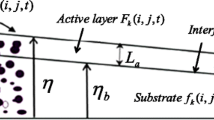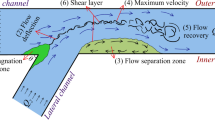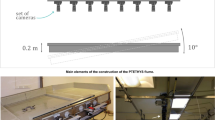Abstract
Numerical simulations for bed change and bank erosion were performed using a two-dimensional numerical model to analyze the effect of channel width variation on bed change for the 4.2 km section upstream of Changnyeong-Haman Weir in the Nakdong River of South Korea. Simulation result of bed degradation without bank erosion for 120 days with 1,000 m3/s of flow discharge was about 2 m greater than the case of simulation with bank erosion. The narrow channel section was continuously degraded over time in the simulation with the fixed boundary for bank lines. However, bed degradation decreased as the channel width increased when bank erosion or artificial width extension were considered in the modeling. The equilibrium condition for topographical changes in the study reach was demonstrated by the modeling results with different channel width and simulation time.
Similar content being viewed by others
References
Ackers, P. and White, W. R. (1973). “Sediment transport: New approach and analysis.” Journal of Hydraulics Division, Vol. 99, No. hy11, pp. 2041–2060.
Arulanandan, K., Gillogley, E., and Tully, R. (1980). Development of a quantitative method to predict critical shear stress and rate of erosion of natural undisturbed cohesive soils, Report GL-80-5, US Army Engineers Waterways Experiment Station, Vicksburg, MS, USA.
Duan, G. J. (2001). “The applications of the enhanced CCHE2D model to study the alluvial channel migration processes.” Journal of Hydraulic Research, Vol. 39, No. 5, pp. 469–480, DOI: https://doi.org/10.1080/00221686.2001.9628272.
Garbrecht, J., Kuhnle, R. A., and Alonso, C. V. (1995). “A sediment transport capacity formulation for application to large channel networks.” Journal of Soil and Water Conservation, Vol. 50, No. 5, pp. 517–579.
Guan, D., Melville, B. W., and Friedrich, H. (2014). “Live-bed scour at submerged weirs.” Journal of Hydraulic Engineering, Vol. 141, No. 2, pp. 04014071, DOI: https://doi.org/10.1061/(ASCE)HY.1943-7900.0000954.
Han, S. W. (2010). Numerical analysis for bed changes due to sediment transport capacity formulas and sediment transport modes using the CCHE2D model. MSc Thesis, Myongji University, Seoul, Korea.
Hanson, G. J. and Simon, A. (2001). “Erodibility of cohesive streambeds in the loess area of the midwestern USA.” Hydrological Processes, Vol. 15, No. 1, pp. 23–38, DOI: https://doi.org/10.1002/hyp.149.
Hydrological Survey Center (2011). Hydrological annual report in 2010, Ministry of Land, Infrastructure and Transport, Sejong, Korea.
Jang, E. K., Ji, U., Kwon, Y. S., and Yeo, W. K. (2013). “Investigation for bed stabilization methods in the upstream channel of haman weir using CCHE2D model.” KSCE Journal of Civil Engineering, Vol. 33, No. 6, pp. 2211–2221, DOI: https://doi.org/10.12652/Ksce.2013.33.6.2211.
Jang, C. L. and Shimizuu, Y. (2005). “Numerical simulation of relatively wide, shallow channels with erodible banks.” Journal of Hydraulic Engineering, Vol. 131, No. 7, pp. 565–575, DOI: https://doi.org/10.1061/(ASCE)0733-9429(2005)131:7(565).
Ji, U., Yeo, W. K., and Han, S. W. (2010). “Numerical analysis for bed changes due to sediment transport capacity formulas and sediment transport modes at the upstream approached channel of the Nakdong river estuary barrage.” Journal of Korea Water Resources Association, Vol. 43, No. 6, pp. 543–557, DOI: https://doi.org/10.3741/JKWRA.2010.43.6.543.
Julien, P. Y. (2002). River mechanics, Cambridge Univ. Press, New York, NY, USA.
Knighton, D. (1998). Fluvial forms and processes: A new perspective, Routledge, London, UK.
Ko, D. and Kang, J. (2018). “Analysis on scour characteristics under river bed variation in weir downstream.” Engineering, Vol. 10, No. 8, pp. 495–504, DOI: https://doi.org/10.4236/eng.2018.108035.
Korea Water Resources Corporation (2010). Implementation design report of Nakdong River restoration 18th sector project (Changnyeong 2 and Haman 1 District), Korea Water Resources Corporation, Daejeon, Korea.
Kwon, Y. S. (2013). Numerical analysis on bed changes considering variation of channel width and bank erosion, MSc Thesis, Myongji University, Seoul, Korea.
Lai, Y. G., Greimann, B. P., and Simon, A. (2013).A coupled stream bank erosion and two-dimensional mobile-bed model, Technical Report SRH-2013-07, Technical Service Center, Bureau of Reclamation, Denver, CO, USA.
Lenzi, M. A., Marion, A., Comiti, F., and Gaudio, R. (2002). “Local scouring in low and high gradient streams at bed sills.” Journal of Hydraulic research, Vol. 40, No. 6, pp. 731–739, DOI: https://doi.org/10.1080/00221680209499919.
Luppi, L., Rinaldi, M., Teruggi, L. B., Darby S. E., and Nardi, L. (2009). “Monitoring and numerical modelling of riverbank erosion processes: a case study along the Cecina River (Central Italy),” Earth Surface Processes and Landforms, Vol. 34, No. 4, pp. 530–546, DOI: https://doi.org/10.1002/esp.1754/abstract.
Midgley, T. L., Fox, G. A., and Heeren, D. M. (2011). “Evaluation of the Bank Stability and Toe Erosion Model (BSTEM) for predicting lateral streambank retreat in Ozark streams.” ASCE World Environmental and Water Resources Congress, pp. 1991–2000, DOI: https://doi.org/10.1061/41173(414)209.
Ministry of Land, Infrastructure and Transport (2009). River master plan report (modified) of the Nakdong river basin. Ministry of Land, Infrastructure and Transport, Sejong, Korea.
Osman, A. M. and Thorne C. R. (1988). “Riverbank stability analysis. I: Theory.” Journal of Hydraulic Engineering, Vol. 114, No. 2, pp. 134–150, DOI: https://doi.org/10.1061/(ASCE)0733-9429(1988)114:2(134).
Proffitt, G. T. and Sutherland, A. J. (1983). “Transport of non-uniform sediments.” Journal of Hydraulic Research, Vol. 21, No. 1, pp. 33–43, DOI: https://doi.org/10.1080/00221688309499448.
Wu, W. (2001). CCHE2D sediment transport model (ver. 2.1 edition), National Center for Computational Hydroscience and Engineering, the University of Mississippi, Oxford, MS, USA.
Wu, W., Vieira D. A., and Wang, S. S. Y. (2000a). “New capabilities of the CCHE1D channel network model.” Building Partnerships, pp. 1–10, DOI: https://doi.org/10.1061/40517(2000)26.
Wu, W., Wang, S. S. Y., and Jia, Y. (2000b). “Nonuniform sediment transport in alluvial river.” Journal of Hydraulic Research, Vol. 38, No. 6, pp. 427–434, DOI: https://doi.org/10.1080/00221680009498296.
Acknowledgements
This research was supported by Korea Institute of Construction Technology (Project name: Development of Floodplain Maintenance Technology for Enhancement of River Waterfront Value, Project number: 2013-0327) and by a grant (11-TI-C06) from Advanced Water Management Research Program funded by Ministry of Land, Infrastructure and Transport of Korean government.
Author information
Authors and Affiliations
Corresponding author
Rights and permissions
About this article
Cite this article
Kwon, Y., Ji, U. & Jang, Ek. Numerical Analysis on Channel Width Variation for River Bed Stabilization Upstream of the Weir. KSCE J Civ Eng 23, 2524–2531 (2019). https://doi.org/10.1007/s12205-019-0739-1
Received:
Revised:
Accepted:
Published:
Issue Date:
DOI: https://doi.org/10.1007/s12205-019-0739-1




